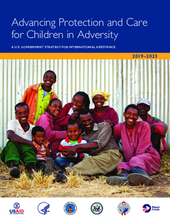United States Government Policy Statement
The United States Government envisions a world in which all children thrive within protective, loving families, free from deprivation, violence, and danger. Advancing Protection and Care for Children in Adversity: A U.S. Government Strategy for International Assistance (2019–2023) outlines the U.S. Government’s whole-of-government commitment and approach to investing in the development, care, dignity, and safety of the world’s most-vulnerable children and their families. U.S. Government par tners involved in implementing this Strategy include the U.S. Depar tments of Health and Human Services, Labor, and State; the Peace Corps; and the U.S. Agency for International Development (USAID).
The goal of the Strategy is to ensure the U.S. Government’s investments for the most-vulnerable children and families around the world are comprehensive, coordinated, and effective in helping place partner countries on a Journey to Self-Reliance by which they can sustainably finance, manage, and deliver services that lead to stable, resilient, and prosperous families and communities. Through implementation of the Strategy, the U.S. Government will leverage and complement its foreign assistance investments in strengthening systems for protecting and caring for children, as well as in health, education, nutrition, and humanitarian response. The Strategy gives particular attention to strengthening families, because nurturing and loving family care is essential for children’s development, protection, and safety
The Strategy starts from the premise that sustainable development depends on the capacity of parents who have the primary responsibility for ensuring the healthy growth and development of their children. Parents, together with other members of their families, communities, civil society, faith-based organizations, and governments, promote the safety and well-being of children, even in the face of formidable threats and challenges. The Strategy recognizes that when children’s safety or well-being is at risk, governments have a responsibility to strengthen families’ capacities to mitigate these risks; or when children and adolescents are outside of family care, governments must take steps to ensure their adequate protection and care. It also recognizes that young people are allies and actors in promoting their own safety and well-being and that of others. In the Strategy, the word children includes newborns, young children, adolescents, and youth under age 18.
The Strategy includes three primary objectives: (1) Build Strong Beginnings, (2) Put Family First, and (3) Protect Children from Violence.
Learn more at the Children in Adversity website here.
Read the blog post by Sarah Gesiriech, the U.S. Government Special Advisor on Children in Adversity, here.

